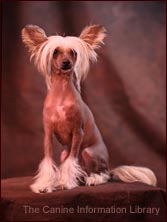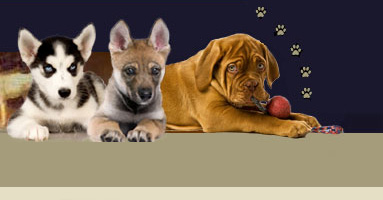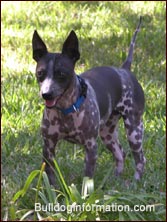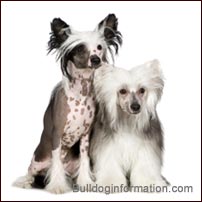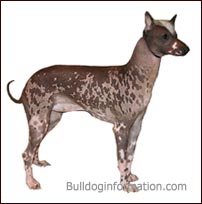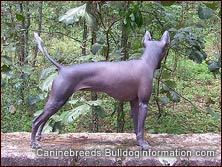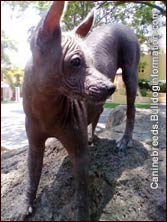Chinese crested of the early 1900s. Note the absense of hair on the toes and tail and the similarity with the South American hairless dogs
Hairless dog breeds have little or no hair or fur. They are clean, odor-free and flea-free and generally less likely to produce allergic reactions. More about hypoallergenic dog breeds >>
Origin
Many authors have tried to relate all naked dog breeds in Asia, Africa and other countries, and find a common ancestor for them, but there is not much evidence to support this theory. According to one theory the Chinese crested's ancestors came from Africa and moved east to Asia.
According to the same theory, all Latin-American hairless dogs, descend from the Chinese crested dogs that were brought to the Latin-American continent by Chinese merchants in pre-columbian times, in exchange for jade and gold. The use of these dogs for healing purposes may have been taught by the Chinese, as well.
They were kept inside and only exercised at night, in order to prevent their ligh-colored skin from becoming darker. They spent their days in rooms filled with orchids, hence the name Peruvian Inca Orchid for these light-colored dogs. The darker Peruvian Hairless dogs, on the contrary, were not as precious and spent their time outside. They were considered 'daytime dogs'.
Hairless Breeds:
American Hairless Terrier: the only hairless breed originating in the U.S. The coated version is called Rat Terrier. Unlike the other hairless breeds, the American Hairless Terrier has a totally hairless body (except for whiskers and eyebrows), with no hair on feet, head or tail.
American Hairless Terrier "Saryn"
Photo: Woodland Manor Kennel
They have a typical terrier character and temperament: energetic, friendly and intelligent. More about the American Hairless Terrier >>
Coated and hairless version of the American Hairless Terrier (Rummy and Evyl)
Photo courtesy of Woodland Manor Kennel
Chinese Crested (hairless): the Chinese crested also has a coated variety, called a Powderpuff.
It is a very affectionate, playful and joyful dog having the additional advantage that, like all other hairless breeds, it has no body odor, no heavy shedding and is less prone to fleas.
More about the Chinese crested.
Manchurian Hairless Dog: a relative of the Chinese crested from the north-eastern region of China.
Hairless Khala: the name is used to refer to a Bolivian breed of hairless dogs, but also, following a theory that all American hairless dogs should be considered of the same origin, as a general name for all hairless dogs that originated in Latin America. Khala is a Bolivian Quechua Indian word meaning "without clothing."
Peruvian Inca Orchid (Moonflower Dog, Inca Moonflower Dog, Inca Orchid Dog, Pero sin Pelo del Peru). Like most hairless dogs, its first purpose was to provide dog meat to the ancient inhabitants of Peru.
It is said that all dogs registered as Peruvian Inca Orchids trace their entire pedigree back to fewer than one dozen dogs. As it is becoming increasingly difficult to obtain additional dogs from Peru, the gene pool may become too limited in the future.
Hairless Dogs
The Naked Truth: The Chinese Crested, Xoloitzcuintli & Peruvian Inca Orchid (Hardcover)
by Amy Fernandez, Rhae Kelly
A major work on hairless dog breeds: Chinese Crested, Xoloitzcuintli, and Peruvian Inca Orchid.
More information:
An additional problem this breed is facing is that some canine authorities do not recognize the Peruvian Inca Orchid as a separate breed, but consider the Inca Orchid, Peruvian Hairless and Xoloitzcuintli one and the same breed. The name suggested to refer to these breeds is "Pre-Columbian Hairless" or " New World Hairless".
The Nahuatl word xoloth, meaning slave or attendant, forms the basis for the name of this dog that is pronounced sholo-its-quintli and literally means 'servant dog', or domestic dog. The basis is found in the name of other domestic animals, such as Huexlotl, the word for common Turkey, which seems to indicate that xoloth was used to refer to animals living within the household or used as food. Morphologically the Mexican Hairless is close to the ancient African pariah dogs, while its personality can be very similar to the Fox Terrier's.
Peruvian Hairless Dog
Originally the same breed as the Inca Hairless dog. The breed differs from the Peruvian Inca Orchid by its skin color, which is dark instead of mottled.
Xoloitzcuintli (Mexican Hairless):
Canine Information Home >
.
.
.
.
The
Canine Information Library 2003-2009 © All rights reserved. Original idea, design and development by C. Marien-de Luca. Photos ©
Woodland Manor Kennel (American Hairless Terrier); Ljupco Smokovski (Chinese crested on brown background); Global Photographers (Chinese crested with Powderpuff); Michael Klenetsky (Peruvian Hairless top view); Eris Isselée (Peruvian Hairless dog) Photos of the Canine Info mascots (upper right corner, from left to right) Husky pup and European wolf cub by Eric Isselée, Bordeaux dog with ball by Paul Cotney. No part of the CaninInformationLibrary.com may be copied, distributed, printed or reproduced on another website without the owner's written permission.
Hairless Chinese crested and powder-puff (coated) variety
Sneeze-Free Dog Breeds:
Allergy Management And Breed Selection for the Allergic Dog Lover
(Paperback)
by Diane Morgan
In-depth breed profiles of 21 hypoallergenic dogs, including four hairless dog breeds. Grooming needs, personality traits, activity levels, health issues, and trainability are described for each dog breed.
More information:
Chinese Crested:
A Comprehensive Guide to Owning and Caring for Your Dog
(Kennel Club Dog Breed)
(Hardcover)
by Juliette Cunliffe
More information:
Contrary to what is stated by some Kennel Clubs and dog books, the Tepeitzcuintle is not the miniature xolo. It is a kind of rodent, better known as "Paca", that is common in the southern part of Mexico, but that is completely unrelated to xolos.
Xolos come in three sizes:
- Standard 46-60cm (18 to 23.5 inches). There is a tolerance from 60 to 62cm (23.6 to 24.5) only if the dog is of top quality.
- Intermediate 36-45cm (14 to 17.8 inches), is also the most common one.
- Miniature 25-35cm. (10 to 13.8 inches)
Intermediate (AKC Miniature) Mexican hairless
Photo courtesy of Giovanna Suedan
Casa Tozani Xoloitzcuintles
Miniature (AKC Toy) Mexican hairless
Photo courtesy of Giovanna Suedan
Casa Tozani Xoloitzcuintles
In the US the intermediate is called 'Miniature Mexican Hairless' and the miniature is referred to as 'Toy Mexican Hairless'.
Ecuadorian Hairless Dog:
One of the most naked-skinned and also rarest of all hairless dog breeds. It has a golden colored skin and long legs. Some authors say it may be a cross between the Peruvian Hairless dog and the Mexican Xoloitzcuinli.
Mexican hairless dog
Photo courtesy of Giovanna Suedan
Casa Tozani Xoloitzcuintles
Hairless dogs are present in Pre-columbian art, where they are often represented with wrinkles to differentiate them from short-haired dogs. The Inca called them alcocala, the Aztec xoloitzcuintli, while the Zapotec referred to them as peco xolo and the Yucatec Maya as ah bil. However, some authors such as Humboldt consider that the term xoloitzcuintli did not refer to a dog, but to a large, hairless, dog-like rodent, just like the Tepeitzcuintle is a small rodent.
Several hairless dog breeds were used as a cure for aches and ailments. The hairless dogs hot-skinned body was applied as a heating pad to the troubled part, or utilized as welcome bed-warmers as a kind of living 'hot-water bottle'. The darker specimens were believed to be the most effective at healing.
In more remote times they were sometimes also raised for their meat by dog-eating civilizations or sacrificed in Inca ceremonies to create rain. Their healing function soon conferred them a status of talismanic animal within the household. The Peruvian hairless dog, for example, was taught to posses supernatural qualities. Many other hairless breeds were thought to bring good luck to their owners.
Some of these hairless breeds and types are now extinct, for example, the African Elephant Dog, Turkish Hairless Dog, Guatemalan Hairless, Thai Hairless Boran Dog, Ceylon Hairless dog and Nubian Dog (see further). Other groups of dogs later developed into recognized breeds, such as the Chinese Crested Dog, the Mexican Hairless Dog, and the Peruvian Hairless Dog.
Genetics
Most hairless dog breeds have dominant genes for hairlessness. If a genetic trait is dominant, a dog only needs to inherit one copy of the gene, either from the mother or the father (not necessarily from both) for the trait to be expressed.
This means that once the hairless trait appears within a dog population this attribute can be passed to their offspring without human intervention. This explains how groups of hairless dogs came into existence in different parts of the world: South-America, the Middle East and North African areas for centuries.
Only one of the existing hairless breeds has a recessive gene for hairlessness and has been selectively bred for this hairless trait, namely the American Hairless Terrier. If a genetic trait is recessive, a dog needs to inherit two copies of the gene for the trait to be expressed. Thus, both parents have to be carriers of the recessive gene for hairlessness to produce hairless offspring. That explains why dogs with a recessive gene for hairlessness are not known in natural conditions.
In earlier times, when the major function of the breed was to serve as meat for the Huancas of Peru, the distinction was of little importance. However, when the breed was adopted by the Inca nobility color became an important criteria, and the pale, mottled dogs were considered more valuable.


